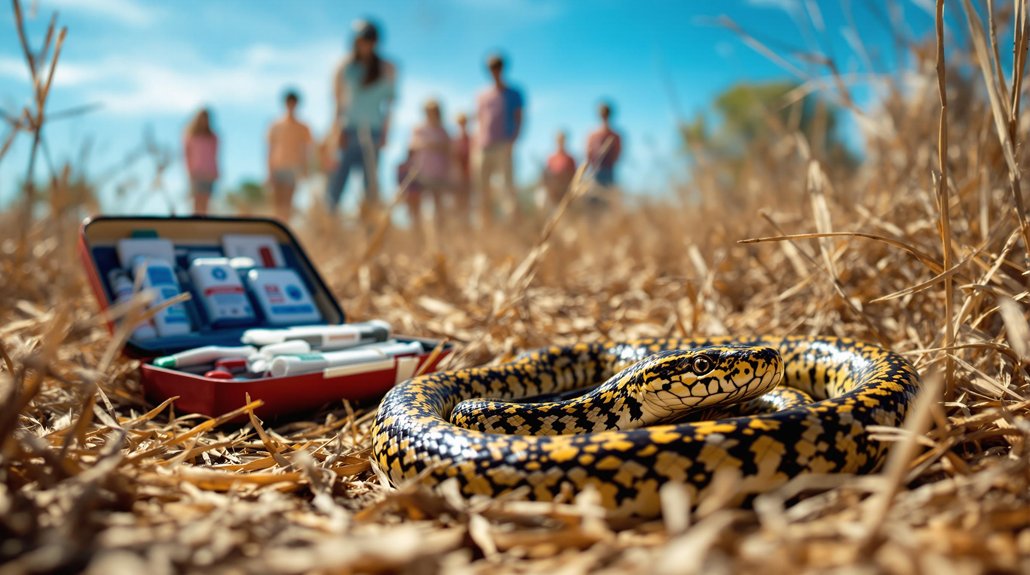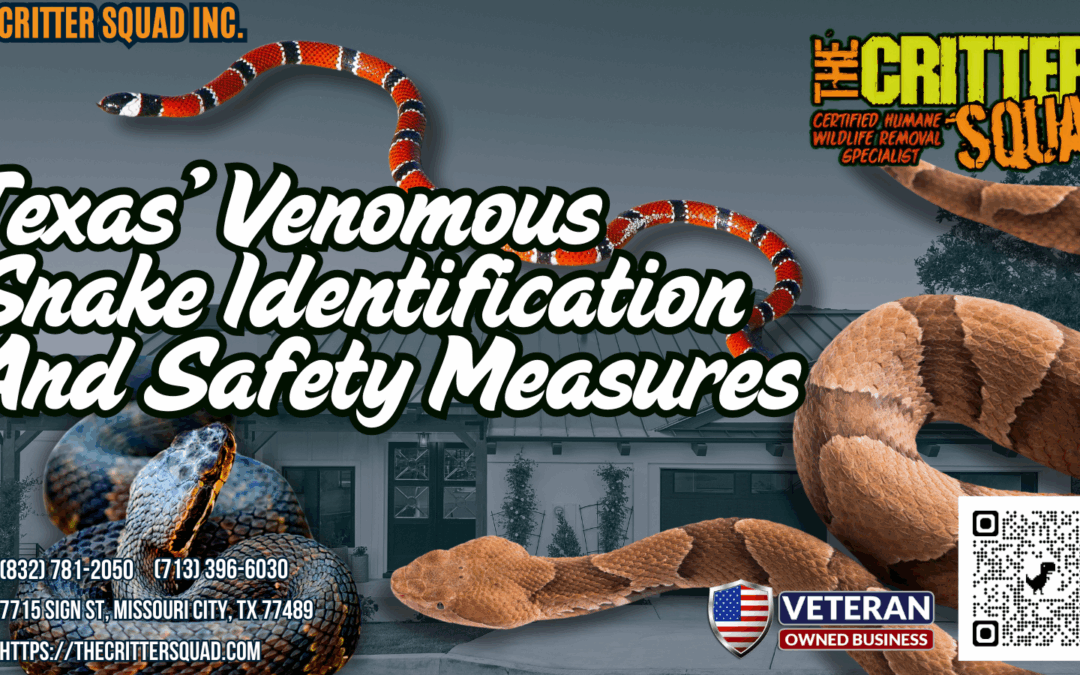Texas has several venomous snakes, including the Western Diamondback Rattlesnake, Copperhead, and Coral Snake. Identifying them is important for safety. Key features include color patterns and head shape. To avoid encounters, keep your yard clean and hike on marked trails. In case of a snake bite, call for help immediately and keep the victim still. Understanding these snakes and their habits can enhance safety and enjoyment in nature. More insights are available on this topic.
Key Article Highlights
- Recognize Texas venomous snakes by their distinctive color patterns; for example, the Western Diamondback has a unique diamond pattern on its back.
- Familiarize yourself with their habitats; Western Diamondbacks prefer dry areas, while Copperheads are found in wooded regions near water.
- Keep yards snake-proof by maintaining short grass, removing debris, and sealing gaps in fences to deter snake presence.
- When hiking, stay on marked trails and avoid tall grass or dense bushes where snakes might hide.
- In case of a snake bite, call emergency services immediately and keep the victim still while waiting for help.
Common Venomous Snakes in Texas
Texas is home to several common venomous snakes that residents and visitors should recognize. These snake species include the Western Diamondback Rattlesnake, Copperhead, and Coral Snake. Each of these snakes has distinct habitat preferences. The Western Diamondback often resides in dry regions, such as deserts and scrublands. Copperheads are usually found in wooded areas and near water sources. Coral Snakes prefer sandy or loose soil environments, often hidden in leaf litter. Understanding these habitats helps people stay aware of their surroundings. Recognizing these snakes is essential for safety in the great outdoors. Awareness of Texas’s venomous snakes can lead to a more enjoyable experience in nature, allowing individuals to embrace freedom with caution.
Key Identification Features
When identifying venomous snakes, certain key features can help distinguish them from non-venomous species. Color patterns are essential. Many venomous snakes have distinctive markings, such as stripes or bands, that set them apart. For example, the Western Diamondback rattlesnake displays a unique diamond pattern along its back. Another feature to take into account is the shape of the head. Venomous snakes often have a wider, triangular head compared to their non-venomous counterparts. Habitat preferences also play a role in identification. Venomous snakes may prefer areas such as rocky hills, dense brush, or wetlands. By observing these characteristics, individuals can more easily recognize venomous species and stay aware of their surroundings in Texas.
Safety Measures to Prevent Snake Encounters
To minimize the risk of snake encounters, individuals should take several proactive safety measures. One important step is snake proofing yards. This can be achieved by keeping grass short, removing debris, and sealing gaps in fences. These actions help create a less inviting environment for snakes. When enjoying the outdoors, it is essential to follow safe hiking tips. Hikers should stay on marked trails and avoid tall grass or dense bushes where snakes may hide. Wearing boots and long pants can also provide protection. Additionally, being alert and aware of surroundings can help spot snakes before close encounters happen. Incorporating professional snake control techniques into yard maintenance can further reduce the chances of unwanted encounters. By adopting these simple practices, individuals can enjoy nature while reducing the chance of snake encounters.
What to Do in Case of a Snake Bite

Even with safety measures in place, snake bites can still occur in the outdoors. In case of a snake bite, quick action is essential. The first step is to remain calm and seek help. First aid should be administered immediately.
| Action | Description |
|---|---|
| Call for help | Dial emergency services right away. |
| Keep the victim still | Movement can spread venom. |
| Remove tight items | Take off jewelry or tight clothing. |
Emergency response is critical for recovery. Do not attempt to suck out venom or apply ice. Instead, focus on reaching medical assistance as fast as possible. Time is crucial in these situations.
Coexisting With Venomous Snakes in Texas
Coexisting with venomous snakes in Texas requires awareness and respect for their natural habitat. These snakes play an important role in the ecosystem. They help control rodent populations and maintain the balance of nature. Understanding their natural behaviors is key to staying safe. Snakes prefer to avoid humans and will usually retreat if given a chance.
To coexist peacefully, people should keep yards clean and free of debris, which can attract snakes. It is also wise to educate oneself about local species and their habitats. When hiking or exploring, staying on designated trails can reduce encounters. By respecting the space and behaviors of venomous snakes, people can enjoy the freedom of Texas’ outdoors while minimizing risks.
Frequently Asked Questions
What Is the Lifespan of Texas Venomous Snakes?
The lifespan of snakes varies greatly. Factors such as species, habitat, and diet influence snake longevity. Generally, many snakes can live from 10 to 30 years, but some may exceed these averages in ideal conditions.
Can Venomous Snakes Swim Well in Water?
Research shows that some snakes can swim effectively, with certain species covering distances of over a mile in water habitats. Venomous snakes, too, possess strong swimming abilities, adapting well to aquatic environments when necessary.
Do Venomous Snakes Hibernate in Winter?
Venomous snakes exhibit hibernation behavior during winter months. They seek shelter in burrows or crevices, slowing their metabolism. This adaptation helps them survive cold temperatures until warmer weather returns, allowing them to resume normal activities.
What Attracts Venomous Snakes to Urban Areas?
Venomous snakes flock to urban habitats like moths to a flame. They are drawn by abundant food sources, such as rodents and warm shelter. This combination creates a tempting environment for these reptiles to thrive.
Are There Any Myths About Texas Venomous Snakes?
Many myths surround venomous snakes, including misconceptions about their behavior and danger. Common venom myths suggest all snakes are deadly, when in fact, only a few species pose significant threats to humans and pets.




























